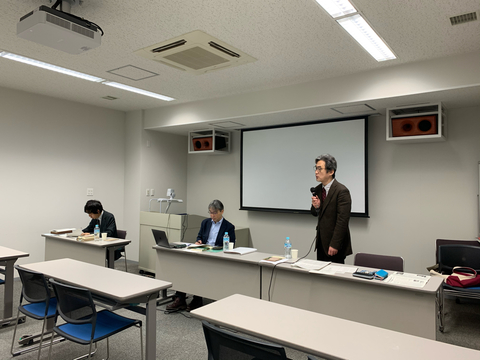Reports
Professors Shinada Yoshikazu Saitō Mareshi were invited to give lectures commemorating the publication of The Origin of “National Texts”—The Compilation of Classical Texts in Modern Japan (Shin’yōsha, 2019), which they co-authored. The book in question discusses how Japanese and Sinitic classical texts were used in Japan during the formative years of its modern national polity while focusing on the establishment details and reorganization process of the classical literature course attached to the University of Tokyo’s Faculty of Letters, established in 1882. Shinada’s lecture was a presentation on topics that served as an extension of the arguments laid out in that book.
In Shinada’s presentation, he showed that Kenpō gige’s interpretation of the term “reign over” in Article 1 of the imperial constitution, “The Empire of Japan shall be reigned over by a single line of sovereigns for a myriad ages,” can be seen as the result of the classical literature courses, and further clarified the relationship between the establishment of the classical literature course as presented in The Origin of “National Texts” and the creation of the imperial constitution. First, Shinada stated how Inoue Kowashi, who is believed to have consolidated drafts of Kenpō gige, corresponded the term “reign over” with the term “to know” as seen in sections on “the transfer of the land” (kuni-yuzuri) in the Kojiki, taking the act of knowing the state of the country as “reigning over” it, and through that devised a system in which a constitutional structure based on the mutual rule of monarch and people could co-exist with the figure of a sovereign who “reigns over” the country. Then, along with pointing out that it was Ikebe Yoshikata from the classical literature course who taught Inoue about the description in the Kojiki, he stated that the imperial proclamation to establish the National Diet, Katō Hiroyuki’s Kokutai shinron, which advocated for a break from the monarchy, going out of print, and the establishment of the classical literature course at the University of Tokyo during Katō’s tenure as Prime Minister, can be seen as a series of successive events. Shinada argued that the classical literature course was created in order to produce people who would be involved in the construction of Japan’s imperial constitution system.

Saitō Mareshi’s presentation focused on the discourse of Mozume Takami, taking up discussions surrounding “written language” and “context” in the Meiji period and arguing that in modern Japan written language became something that could be understood as an analogy or metaphor for the national polity. Saitō first mentioned that the term “written language” was widely used after the Meiji era to refer to styles of writing such as “colloquial speech” and “literary style” or “Japanese literary style” and “Sinitic literary writing,” and the term “context” was also often used following the Meiji period to indicate the era and region in which a word was used. Next, he pointed out that while Mozume preached the importance of distinguishing between contexts such as “ancient,” “medieval” or “Sinitic” while making compositions, from the perspective of dissecting language, he discovered the idiosyncrasies of kundoku style as having no attitudinal expression, and considered that as a drawback of the style. On the other hand, because of this particular characteristic regarded by Mozume as a flaw, the modern kundoku style became one that could create a public space and resulted in the formation of a new literary context. Finally, as a progression following Mozume, Saitō argued that the idea that a literary style could encompass multiple contexts became dominant in place of the idea that one selects specific contexts, and together with using as an example Tayama Katai’s Bibun sahō, which advocated for “beautiful words” as a high-level concept, the Man’yōshū as a “national text” could also be considered as having materialized based on the same idea.

During the Q&A section, Professor Tokumori asked about the possibility that the term “to know” was a ubiquitous example of “to reign over.” In response to that, Shinada mentioned that the Japanese monarchy was perceived as differing from that of Western monarchies, and stated that, in Japan’s particular case, “to reign” was exemplified by the act of “knowing.” Tokumori also asked about the continuity between the classical literature course and the prior kokugaku movement of the Edo period. Both speakers in response answered that it is strongly suggestive that the Meiji state used kokugaku texts in the classical literary course, but it is hard to think of it as simply continuous.
After that, discussions were held with the participants about topics such as what form Mozume idealized as the national writing style, the relationship between the formation of the high school curriculum and the classical literature course, and the differences between ancient conceptions of “country” and the modern nation.
These days, “classical texts” may be imagined as relics of the past. However, as was shown in this lecture event, classical texts can have deep ties to both present and future. After learning about how the words accumulated from the past were used as grounds for presenting doctrine or as a practical resource in the Meiji Period, when there was demand for the creation of a new language alongside the construction of a new nation, I felt there was much to think about in regard to the relationship between classical texts and the present day.
(Tobita Hidenobu, PhD Student, University of Tokyo)



